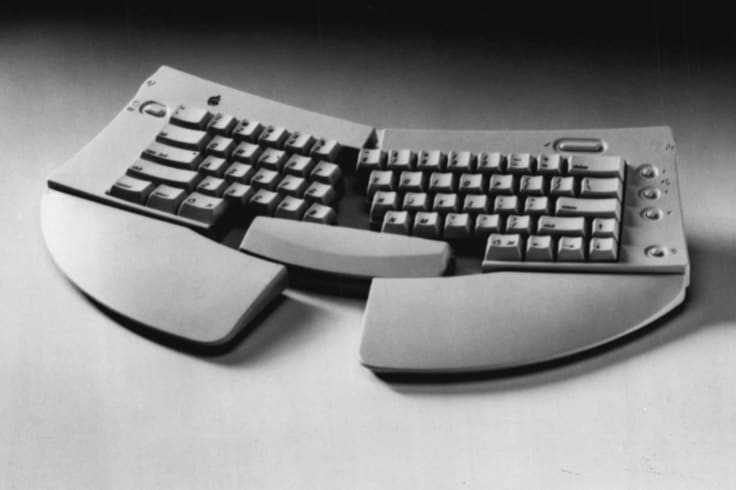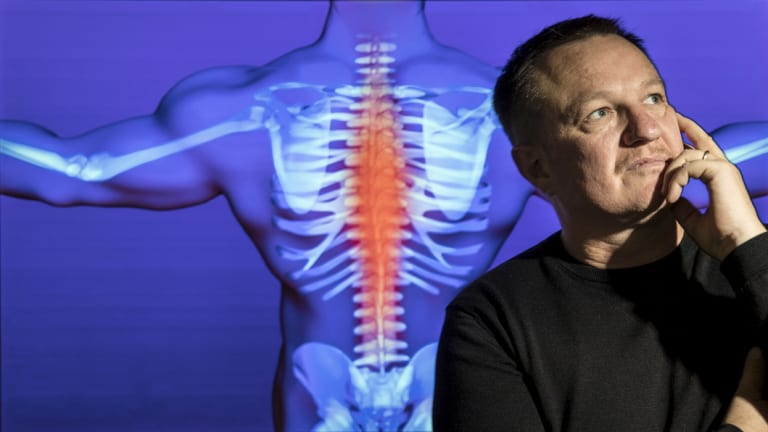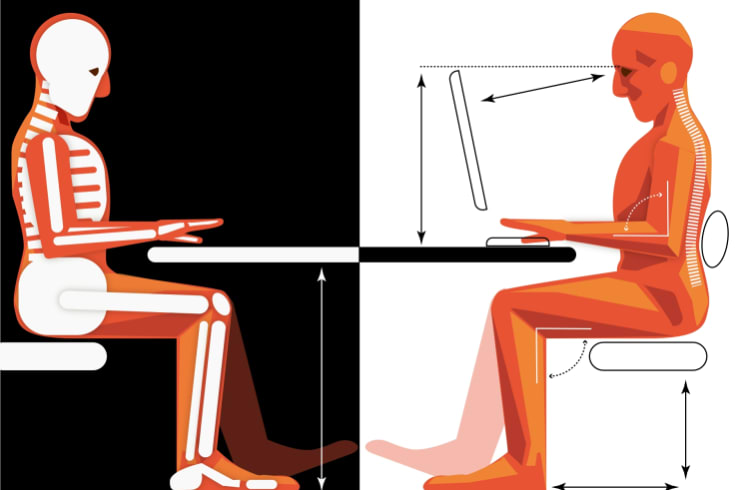Every year, companies around the world spend hundreds of millions of dollars on ergonomic chairs, keyboards and consultants, believing they are taking science-backed steps to care for their workers.
Ergonomists are regularly called as expert witnesses in court, where their findings can decide workplace injury claims worth hundreds of thousands of dollars. Ergonomics is promoted by work safety organisations around the country.
Yet “ergonomics does not have a firm basis in science”, says Sydney University professor Chris Maher, a leading authority on back pain.
Sydney University professor Chris Maher, one of the world’s top back pain experts.
He has been telling ergonomists for years that most of their interventions lack evidence to show they work. They don’t want to hear it, he says: “I have been astonished that the ergonomics industry has been allowed to get away with this for so long.”
Ergonomics is a science, meaning it is supposed to be based on evidence.
But many standard "ergonomic interventions", like the desk adjustments that nearly every office worker has experienced, lack evidence to show that they work.
Some parts of ergonomics may even be harmful, new science suggests.
Meanwhile the profession is concerned that “thousands” of people may be calling themselves ergonomists despite having no formal qualifications or training.
What's in a name?
There are only 82 certified professional ergonomists in Australia, says the Ergonomics Society, plus another 250 or so full members qualified to practice.
“But there are thousands of people calling themselves ergonomists who aren’t,” says Associate Professor Jodi Oakman, head of the Centre for Ergonomics and Human Factors at La Trobe University.
Apple’s Adjustable Keyboard, 1993. Such keyboards are said to make typing more comfortable, but the company stopped short of claiming they would help in cases of repetitive strain injury.
These people are going through workplaces adjusting desks and chairs, sometimes without any training at all.
“People will go out doing ergonomic work station assessments, they’ll call themselves an ergonomist – and they have no training whatsoever. It’s not a protected title,” she says.
Fairfax Media spoke to more than a dozen experts and reviewed hundreds of pages of studies looking at key ergonomic interventions.
These interventions, which included moving monitors and keyboards, changing desk heights and installing new keyboards and mice, are designed to prevent office work-related injuries.
Safework Australia recorded more than 360,000 work-related musculoskeletal disorder compensation claims between 2009/10 and 2013/14 – 60 per cent of all claims in that period. More than half were back and shoulder injuries.
It’s hard to get firm figures on how big the industry is, but the Australian office supply market is tipped to generate $10.1 billion in revenue this year, according to IBISWorld.
The firm's analysts believe the slice of that supplied by the ergonomics industry is rapidly increasing. That fits with three ergonomics firms interviewed by Fairfax Media, who all said the industry had enjoyed explosive growth in the last 15 years.
“I think it’s a load of rubbish,” says Associate Professor James McAuley, a top back pain researcher.
Peter O’Sullivan, professor of musculoskeletal physiotherapy at Curtin University, laughs when asked about ergonomics’ scientific support: “This thing, it’s built like a house of cards.”
Of all the evidence reviewed by Fairfax Media, perhaps the strongest comes from Cochrane, a non-profit NGO formed to look at medical research findings.
The reviewers at Cochrane scour reams of studies in a quest to synthesise the best scientific evidence. Five times they have looked directly at ergonomics – for carpal tunnel syndrome and for preventing and treating work-related arm, neck and shoulder pain.
Using an "alternative" mouse combined with a shoulder support probably reduced the risk of neck and shoulder disorders, although alternative mice did nothing on their own.
Beyond that, they could not find strong evidence showing any of the interventions worked.
A 2015 review published in the British Medical Journal managed to discover some moderate-strength evidence that having someone adjust your desk or monitor did not work at all.
These "adjustments" are the "bread and butter" of what ergonomists are called in for, one leading consultancy told Fairfax Media.
Maher is blunt. “It’s an area of research that’s littered with bad studies. And once you ignore the bad studies, you’re left with studies showing it does not work.”
An unusual invitation
About 15 years ago, an unusual invitation dropped on Maher’s desk. The nation’s ergonomists were having a conference in Cairns, and they wondered if he would speak.
Professor Maher is one of the world’s top back pain researchers, as well as being a fellow of the Australian Academy of Health and Medical Sciences. He’s a scientist’s scientist, interested only in what can be established with hard data.
Maher took the room through the evidence. There was, he said, almost none.
“I did not get very well received,” he says drily. “People did not talk to me at morning tea. But my job is to summarise the evidence that’s out there. I don’t have vested interests in this area. I’m paid by the government as a researcher.”
Maher has spent close to two decades building a database of high-quality empirical research for a range of physiotherapy treatments. He is yet to see a rigorous study that supports ergonomics.
He is far from alone in his views. Curtin professor O’Sullivan calls ergonomics “the science of belief”.
“You can have pain associated with sitting, but it does not mean the way you sit caused it," he says. "The evidence, as I have seen it, suggests ergonomic interventions are no more effective than non-ergonomic interventions. They have not reduced the burden of back and neck pain.”
The idea that a bad mouse, or the wrong chair, or a poorly-adjusted desk can injure you may be dangerous, says McAuley, who leads a pain research group at Neuroscience Research Australia.
“It promotes the idea there is a correct way to sit – that’s just rubbish. There is no correct way to sit.
"In our research we see people all the time who have been advised to sit up straight at their desk. This has just made their pain worse.
‘I think it’s rubbish’: James McAuley, a leading back pain researcher at Neuroscience Research Australia.
“As far as preventing musculoskeletal pain goes, I think that ergonomics is rubbish, I think it’s possibly dangerous.”
In Maher's view, none of ergonomics' interventions work.
- Standing desks: “There is no evidence they are effective for controlling work-related musculoskeletal disorders.”
- Ergonomic redesigns of the workplace: “We don’t know if that works.”
- Interventions to cut back pain: “People still think about fancy chairs, fancy desks. If you’re going to invest in trying to cut back pain, your best bet is to do … exercises. That’s the only thing that’s got evidence for it."
Meanwhile, qualified ergonomists have their own issues – particularly with ergonomic furniture.
They complain that because the term is not protected – like, say, medical claims on food and drugs.
“I don’t like a product being given the title ‘ergonomic’ – it’s not correct. If you don’t know who I am, what my job is, you cannot know my ergonomic requirements,” says Leon Straker, a Distinguished Professor at Curtin University and the British National Health Service’s first ergonomist.
“People often ask me ‘what’s the best ergonomic chair?’, and I say ‘a wooden church bench’. Because you’ll feel so uncomfortable that you’ll have to get up after a half-hour,” he adds.
Ergonomics in action.
Ergonomics is now about looking "holistically" at the worker in the workplace, rather than desk or chair design, says Stephen Hehir, chair of the Human Factors & Ergonomics Society of Australia's professional affairs board.
Fairfax Media put the studies and expert opinions we collected to the society, who took them to a board meeting to be considered, before releasing a statement saying it “agreed with many of the opinions you express, though perhaps not for the reasons you might assume”.
The society was critical of many of the interventions.
“If someone attempts to deal with back pain for a sedentary worker, and all they do is adjust their seat height and add a bit of lumbar support, not only have they missed the point, but they clearly don't understand the fine points of applied low back biomechanics and they obviously have no idea what practicing effective ergonomics is all about,” Hehir said.
A desk adjustment wasn’t ergonomics at all, he added, and the “right-angle erect seated posture promoted by some in the furniture industry” was simply wrong.
But he said the analyses that suggested a lack of evidence for ergonomic interventions were flawed.
Many of the studies, like Cochrane's, weren't published in leading ergonomics journals, and most of the interventions they tested weren’t done by qualified ergonomists, he said.
"Imagine if they were reviewing surgical outcomes and including those operating without a medical licence rather than only qualified surgeons," he said.
Ergonomists are still regularly called on as expert witnesses, a review of court documents found, where they testify if workplace design, furniture or practice might have contributed to an injury. One ergonomics consultancy told Fairfax Media they saw “hundreds and hundreds” of cases a year.
“We’re asked for ergonomic opinions as to what happened and why and what could have been done to prevent it. When they show they weren’t shown how to do things properly, they win more than they lose,” the veteran consultant said.
It all deeply concerns Maher. “I would be concerned if the ergonomist gave advice that a poor office or desk setup caused or contributed to a worker’s injury because we just don’t have the evidence to support such a statement,” he says.
A costly intervention
Lisa-Maree Cakir is one worker who was awarded tribunal-ordered compensation – after she suffered an injury caused by an ergonomics intervention.
Cakir was working as a web publishing officer with the Department of Employment and Workplace Relations when she was given an “ergonomic assessment of [her] workstation” by an injury management consultant, according to tribunal papers.
The consultant performed a desk adjustment on her workstation, and then prescribed her an S-Board, one of the dozens of different types of ergonomic keyboard. They are much smaller than a normal keyboard, allowing the mouse to sit closer to the keys – which is supposed to be good for the shoulders.
Cakir told her supervisor it made her neck and shoulders ache. Her department's health and safety officer told her to keep using it for a few more weeks, tribunal papers show.
But her pain grew and grew, until she had to go on extended sick leave.
She later asked Comcare, the public service workers' compensation insurer, for compensation for the injury – then took them to the Administrative Appeals Tribunal when they rejected her claim.
She alleged the S-Board and a “poor ergonomic setup” led to her injury.
Comcare argued the "workstation was ergonomically assessed by a suitably qualified person and ergonomically approved equipment was provided, and it is simply implausible to claim that an injury resulted from these changes".
The tribunal disagreed, finding her injuries came from the S-Board and "changes in the ergonomic arrangement of her workstation", and ordered Comcare to compensate her and pay her costs.
'The evidence is missing'
Ergonomists who spoke to Fairfax Media almost universally acknowledged the field has an evidence problem. They have different suggestions for why.
“One of the reasons there is not gold standard evidence for ergonomics is because it’s unethical not to do ergonomics,” says Straker.
Because the field believes ergonomics works, deliberately putting someone in an un-ergonomic environment would be unethical. Hence, it is argued, you cannot test if it truly works.
And pain from working at a desk is a lot harder to measure than, say, whether you have cancer or not. Capturing improvements in tiny signals is another real challenge for ergonomic studies, says Straker.
An additional problem is that it’s really hard to measure the impact of ergonomic interventions, says Oakman, because they have to be tested in an office rather than a lab, where it is hard to establish controlled conditions.
“The evidence is missing, or the quality is poor – because of the challenges in undertaking workplace studies,” she says.
"Often reviews of the scientific literature only focus on randomised control trials which are very difficult and often inappropriate for workplace studies. The absence of evidence is not necessarily evidence of absence of effect."
Critics aren’t buying it.
“It’s nonsense. There are trials with interventions that are way more complex than this,” says Maher. “We do placebo-controlled trials of surgery. Those people who say it can’t be done, they are ignoring the studies that have been done but come back negative.”
In an effort to close this gap, University of Queensland associate professor Venerina Johnston and her colleagues set out to conduct a proper randomised trial on ergonomic interventions to reduce the impact of neck pain in office workers
They split a pool of 763 office workers into two groups. The first group received an ergonomic adjustment of their desk plus some health education, while the second got the adjustment and a program of neck exercises.
Remarkably, workers in both groups took more sick leave after the intervention started than they had before, and productivity loss increased.
“Generally, ergonomic interventions don’t show much change in terms of musculo-skeletal problems,” Johnston concludes.
Source: Read Full Article




